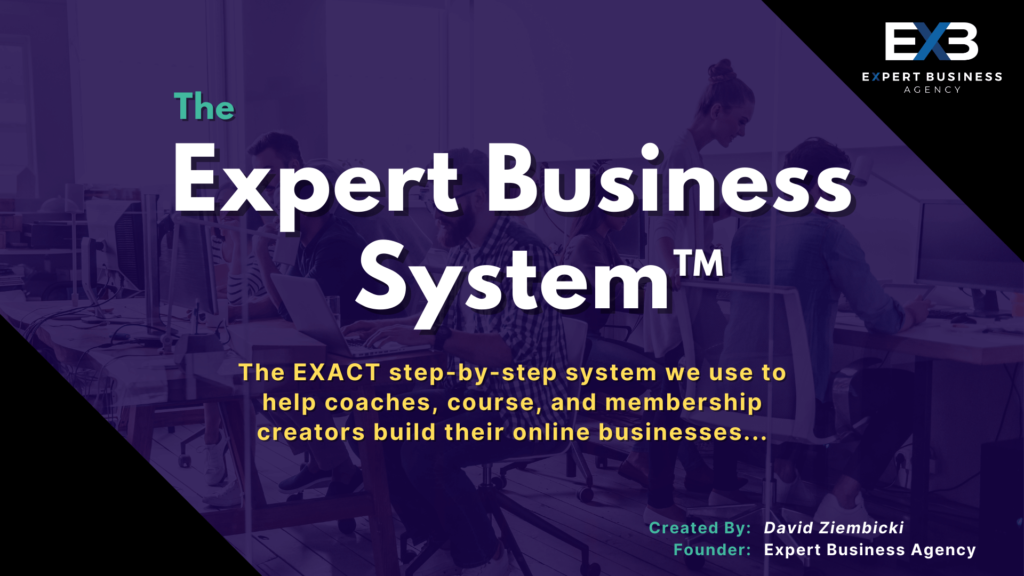
The purpose of the Expert Business System is to provide a step-by-step plan for how to build, scale, and automate an online business around your expertise.
There are companion video trainings and resources for his case study in our free community. Join our Facebook group here.
If you have an existing business, this could mean adding courses, memberships, or group coaching. If you have an expertise but no business yet, this guide outlines every major step you need to build, scale, and automate an online business.
Introduction
Here’s what the Expert Business System covers:
- What type of online business to build
- How to build an online business
- How to get your online business built FOR you
With the massive economic challenges and uncertainty in the world, building a revenue generating online business is an essential step toward controlling your financial future and lifestyle.
When you first start thinking about building an online business or adding an online revenue stream to your existing business, it’s exciting! Imagine the possibilities, the “passive income”!
You see the success stories, the 6-figure blog, the 7-figure podcast, the large social media followings and so on.
From the outside, it looks achievable: “I can write a blog a week”, “I can figure out how to do a podcast”, “I can post on social ten times a day”.
So you dive in and get started! “But wait, how do I build a website? Does a blog need a website? Should I use WordPress or something else? What plugins do I need?”
“Well I see Guru A has a $2,000 master class on how to build a blog so I better take that to accelerate my learning…”
“Looks like I might also need to learn SEO if I want anyone to ever see my blog…”
“Well now it looks like blogs by themselves don’t work, but Guru B recommends blog + podcast so I better buy the $2,000 podcast master class too and get that going”
“I wonder which microphone I should buy for the podcast? I hope editing each episode doesn’t take too long, I wonder what software to use.”
You get the idea… As you start down this path, you don’t know what you don’t know. As you begin to learn what’s required for success, the list of things you need to learn and implement grows much larger than the amount of time or expertise you have...
On this path, you can easily spend thousands, even tens of thousands of dollars “learning” and have nothing to show for it. In the example above which is very common, notice there isn’t any thought yet of what the person will actually sell!
At this point they may turn to “virtual assistants” trying to find $6/hr resources that are experts in all things online business (not realizing that if there was such a unicorn, they’d be charging a lot more or more likely building their own business!) If instead they hire multiple VAs they’ve just turned themselves into a project manager, not a CEO.
Now realizing it’s not working, they look for another answer. At this point, the gurus they follow will be pitching them “high end masterminds”. If the $2,000 course didn’t work out, maybe the $15,000 mastermind will! Direct access to the guru! Monthly group coaching calls!
MANY people get to this point, tens of thousands of dollars and thousands of hours spent without making a single online sale. They spent all their time and money learning but not executing. Consuming instead of creating.
If you don’t find a better path, you will burn through all of your cash, time, and energy.
Why this is relevant for you RIGHT NOW!
If you have already started down the online business path, then I know from having spoken to and working with hundreds of online entrepreneurs that at least some of the example above resonated with you (or maybe made you cringe). If it hit close to home, don’t worry, I’ll show you a different path to success.
If you haven’t started your online business yet, then you are about to save a massive amount of time and headache by starting with a proven blueprint.
Regardless of where you are right now, getting to a point where you are generating a consistent profit from your online business is essential to income diversification and financial freedom.
The question is how to get there…
What you’ll see in this blueprint runs contrary to the advice of many “gurus” of online business. It’s not about blogging or creating content for years before you finally sell something. It’s not about building a massive email list before you finally sell something. It’s not about building a $9 product leading to a $20 product, leading to a $100 product, and someday maybe a $500 product.
This system will show you how to build (or rebuild) an online business extremely rapidly so that you have ALL of the pieces in place to begin generating revenue as quickly as possible.
This is NOT a get rich quick scenario. It is NOT passive income. It takes hard work and dedication. But we are going to show you how to scale quickly without you having to work 100 hours / week…
Why should you trust my advice?

If you haven’t seen any of my other content yet, allow me to introduce myself, how I can help you, and why I want to help you.
My name is David Ziembicki. I’ve had a successful career as an elite technology consultant working for Microsoft for 15 years and a number of consulting firms before that. In my career I’ve personally sold or delivered over $200M of consulting services. I’ve trained and mentored hundreds of technical professionals.
For the second half of my career, I decided to start building an online business to both diversify my income streams and help others do the same.
I QUICKLY MADE ALL OF THE MISTAKES MENTIONED IN THE EXAMPLES ABOVE!
Tens of thousands of dollars spent on courses, masterminds, and tools. Wasted time and money on flaky virtual assistants. Chasing shiny objects and trends (SEO, chatbots, etc.) Little to show for it after several years.
That was a very tough pill to swallow having been highly successful in my career to that point.
Eventually I hit a wall: it was time to give up, or completely change direction. I never give up, so changing direction was the next step.
I started researching, interviewing, and working with successful, 6, 7, and 8-figure online entrepreneurs to reverse engineer their success.
I found that all of them had struggled like I had and like you probably are.
The ones that eventually succeeded ALL had to completely change their approach. Every one of them:
- Stopped trying to do everything solo and built a team
- Stopped learning HOW to do things (tech, SEO, Ads, etc.) and started learning WHO could do things for them
- Stopped selling low ticket / low dollar solutions and started selling high ticket, premium solutions
In the end, I learned that ALL of them had built teams of 10 – 20 employees or freelancers, hired a project or business manager to be their second in command, and built processes and procedures that freed up the founder/CEO to focus on new products and marketing.
At that point, I was slightly deflated because that seemed to mean that you’d have to struggle with slow growth for 5 – 10 years before being able to hire a team to really scale. Remember that all the gurus who are highly successful today actually started 5 – 10 years ago, they just seem like an overnight success.
That is when a massive lightbulb went off in my head: What if I built a team of experts like the 8-figure online business owners had and SHARED that team, the strategy, tools, processes/procedures, ALL of it with other highly motivated, aspiring online entrepreneurs?
In the rest of this guide, I’m going show you exactly how to build, scale, and automate an online businesses built around your expertise and the results you can deliver.
You can execute this blueprint on your own if you’d like, or at the end I’ll show you how we can do a large portion of the work for you!
The Expert Business Roadmap (“What to build”)
The key to success in online business comes down to doing the right things, in the right order, as fast as possible and quickly learning from any mistakes you make.
After reverse-engineering all the successful online entrepreneurs mentioned above, we created a 9-step roadmap that we use with all of our clients.
Our roadmap puts you on a path to generate revenue as soon as possible while building the key elements required for long-term success.

Step 1 – Build Your Own Expert Business Blueprint
Once you’ve read through this guide once and understand each of the steps, the first step to making it real for you and your expert business is to customize this blueprint to make it your own, the master plan for your business.
The first task is determining which of your skills or expertise to begin building your business around. We recommend performing an expertise inventory.
The purpose of this exercise is to find the expertise or skills you already have with the best balance of true expertise, high value, high demand, enjoyment level, and ability to position yourself as an expert.
You may have an expertise in something but you don’t really like doing it anymore. You may have an expertise that just doesn’t have much demand. Instead of focusing on those you want to find one that ranks well in all of the dimensions above AND you would enjoy focusing on for the next few years.
Here are some of the questions and tools you can use to do your own expertise inventory:
- What industry do you work in?
- What is the highest hourly rate in your industry?
- What is your primary skill/expertise?
- Write down any other major skills / expertise you have
For each skill, rank these factors:
- How much do you enjoy this skill/expertise? (1 – 5; 1 if you hate it, 5 if your life’s calling)
- Where do you rank your level of expertise? (1 – 5; 1 is entry level, 5 is in the top 1% of your industry)
- How in demand is this skill/expertise (1 – 5; 1 is low demand, 5 is extreme demand)
- How valuable is this skills / expertise (1 – 5; 1 is low value/commodity, 5 is very high value)
- How many years of experience do you have?
The main idea is to find the highest ranking score with a good balance of enjoyment, demand, and value.
With that skill in mind, the next step is determining your Mission, Market, Outcomes, and Business.
Mission: Your mission is the overall impact you want to have with your expert business. As an example, my mission is to help 1,000 skilled professionals build 7-figure businesses that have a positive impact on their customers and deliver them financial freedom.
Your mission statement should follow a format like:
I help ___________ achieve __________ without _______ so they can ________.
You will populate your mission statement once you have worked through the rest of the roadmap.
Market: Your market is the audience that you want to serve and attract as customers. This is critically important, especially in the beginning. You need to find a sub-market or niche that your skills or expertise are uniquely suited for. This takes the form of a Market, sub-market within, and niche within the sub-market.
Outcomes: Now that you have your mission and your market, you need to determine what outcomes or solutions you can provide to your market. Can you help them improve their health, wealth, relationships, or some other area? With the expertise you’ve chosen to focus on, think about the most desirable outcome you can provide through teaching, coaching, consulting, etc.
Business: The final element of your blueprint is the business model and product “value ladder” that you will build. There are many different types of expert businesses including freelancing, consulting, coaching, online courses, masterminds, information products, etc. Many include two or more of those categories. Nearly all successful online businesses build a value ladder, a set of products/services ranging from free to very high priced solutions. At this early planning stage, you should be thinking about an entry level, flagship, and high-ticket products/services.
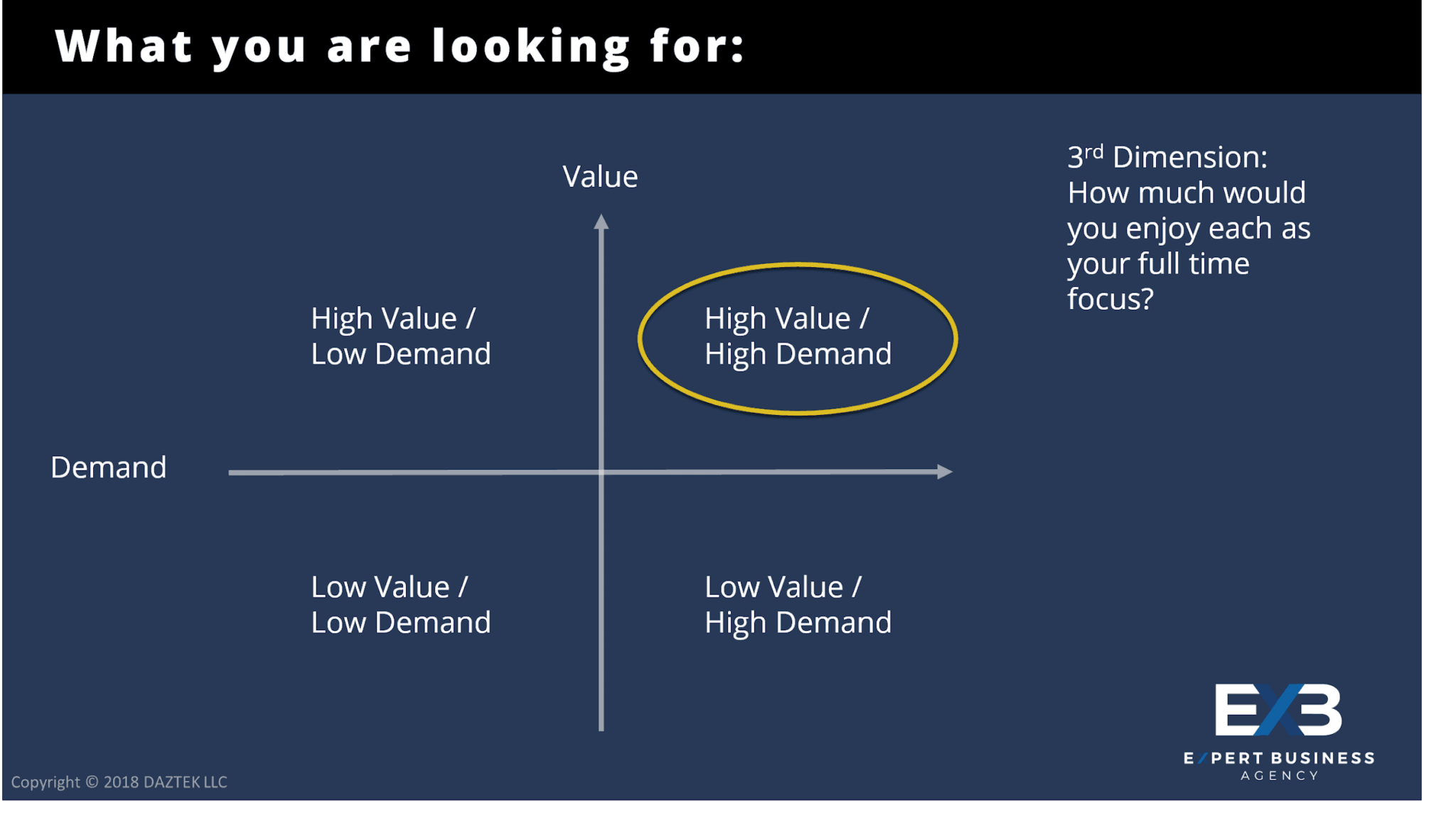
Checklist: Build Your Own Expert Business Blueprint
- Perform an expertise inventory
- Find your business topic by ranking your skills by enjoyment, expertise, value, and demand
- Determine your mission
- Determine your market
- Determine the outcomes you can provide
- Determine the business you want to build
Step 2 – Productize Your Expertise
With your blueprint in place, the next step is to start productizing your expertise and defining in more detail each element of your initial value ladder.
Here’s an example of what that looks like:
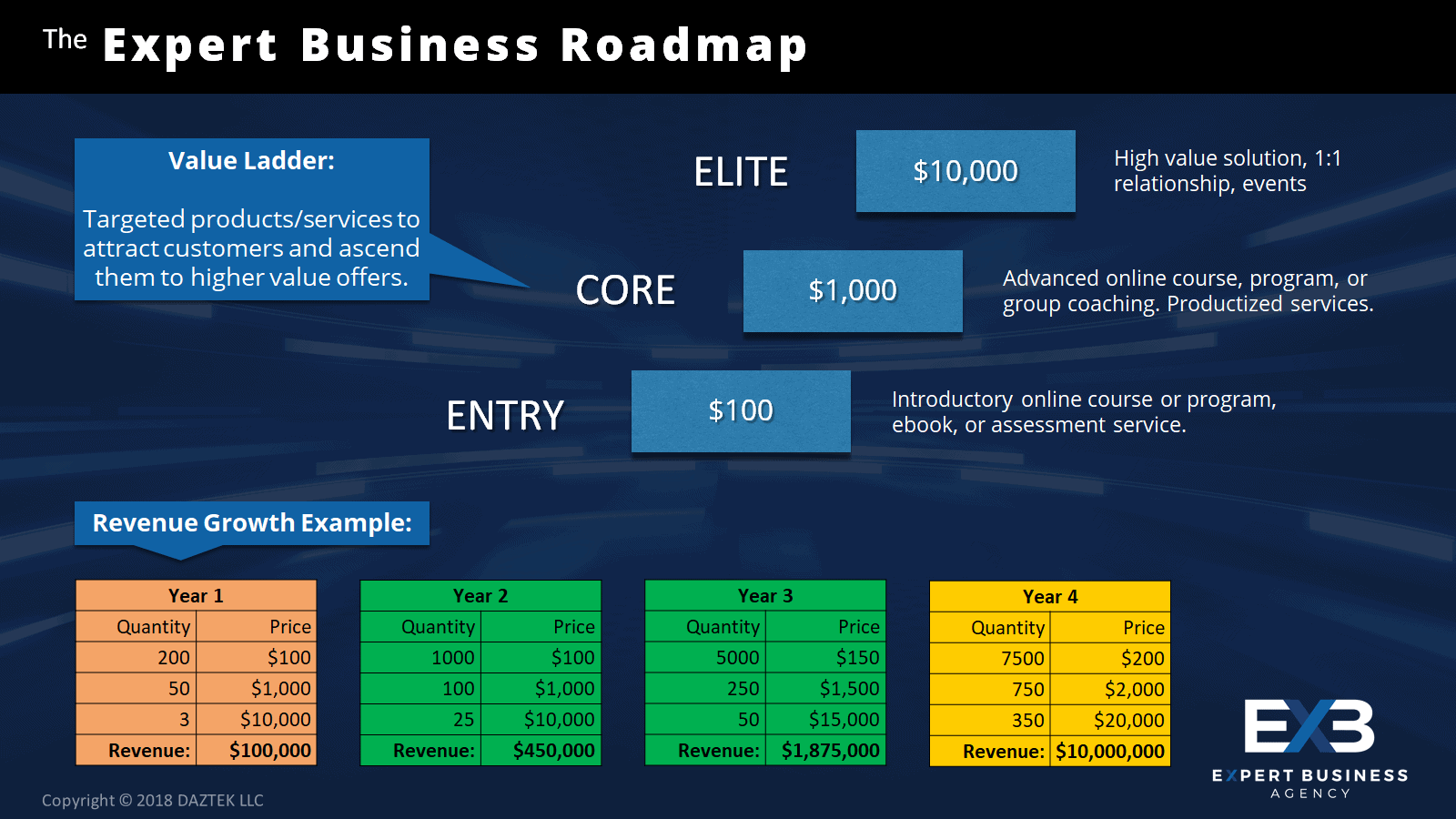
This step is where we take a completely different approach than most of the guidance you may have seen. Many have you start with free or very low priced products (i.e. $19 min-course), then a $97 course, then someday a $997 course, and after many years, and $9997 mastermind.
Instead, we strongly recommend starting with the highest ticket product/service first. This seems counter-intuitive because a low priced product is “easier” to sell, but in today’s world, the most important factor is generating cash flow and profit that can be rolled into paid traffic. The days of putting up a basic blog and then Google sending you tons of free traffic are over.
By starting with high-ticket, even just a few sales at that price point completely change the numbers and increase the odds of success. Crucially, those who don’t take you up on your high ticket offer can be offered downsells to other products in your value ladder.
Course & Membership Revenue Calculator (valued at $97)
As an example, my agency focuses on selling our premium, done-for-you (DFY) program called Accelerate. For prospects that aren’t ready for that yet or that don’t have the budget for that level of service, we have downsells to a done-with-you (DWY) group coaching program as the next tier down, then at our lowest tier, we have a do-it-yourself (DIY) online course.
In this step, you need to define what each of those value ladder elements are and create a specification for them. The specification is like a blueprint for each product: what it is, what it provides, features, benefits, etc. If it’s an online course then the specification would include the course objectives, target audience, outline of modules/lessons/topics. Any materials like workbooks or quizzes associated with it, marketing materials required, and so on.
IMPORTANT: Do NOT start building any of this yet. These specifications are your starting point for testing your product plans. You don’t yet have data proving that these will resonate with your target market. You need to validate these product ideas before investing the time and money building them.
Through the rest of the blueprint you will keep coming back and working on your products as you collect more data. Building your products is an iterative process and you don’t want to move to the next step until you’ve confirmed the previous step.
Checklist: Productize Your Expertise
- Map out your value ladder
- Define a high ticket / elite product/service (typically a 1:1 solution)
- Define a flagship / core product / service (typically course / group coaching program)
- Define a entry / tripwire product (typically an information product)
Step 3 – Fire Up Your Funnels
The absolute best way to test your product ideas is to start selling them, BEFORE they are built! Surveying people, asking if they sound like a good idea, asking “how much would you pay for X” are NOT effective in testing your ideas. The true test is whether someone takes out their credit card and buys the product.
“Is it ethical to sell something before it’s built?” YES, if you properly disclose that fact, it’s not only ethical but beneficial. You can invite the buyer to shape the product or program. Here’s what this looks like “Buy now to become a founding member of XYZ online course. Your input will be used to shape the final content of the courses which will launch in 4 weeks”
You might also be asking, “how do I sell something if I don’t even have a website yet. And why is that Step 4 instead or right now?
Great question, here’s why: It is far faster to setup a sales funnel (a collection of web pages leading to a product sale) than to build a full website. We want you to be testing your product ideas and pre-selling them as fast as humanly possible so you start collecting data on how well your product offers are resonating with your audience. If they do right away, great! More likely is that it will take multiple iterations before you land on the offers that really resonate with your audience. The sooner you start iterating, the sooner you find the winners.
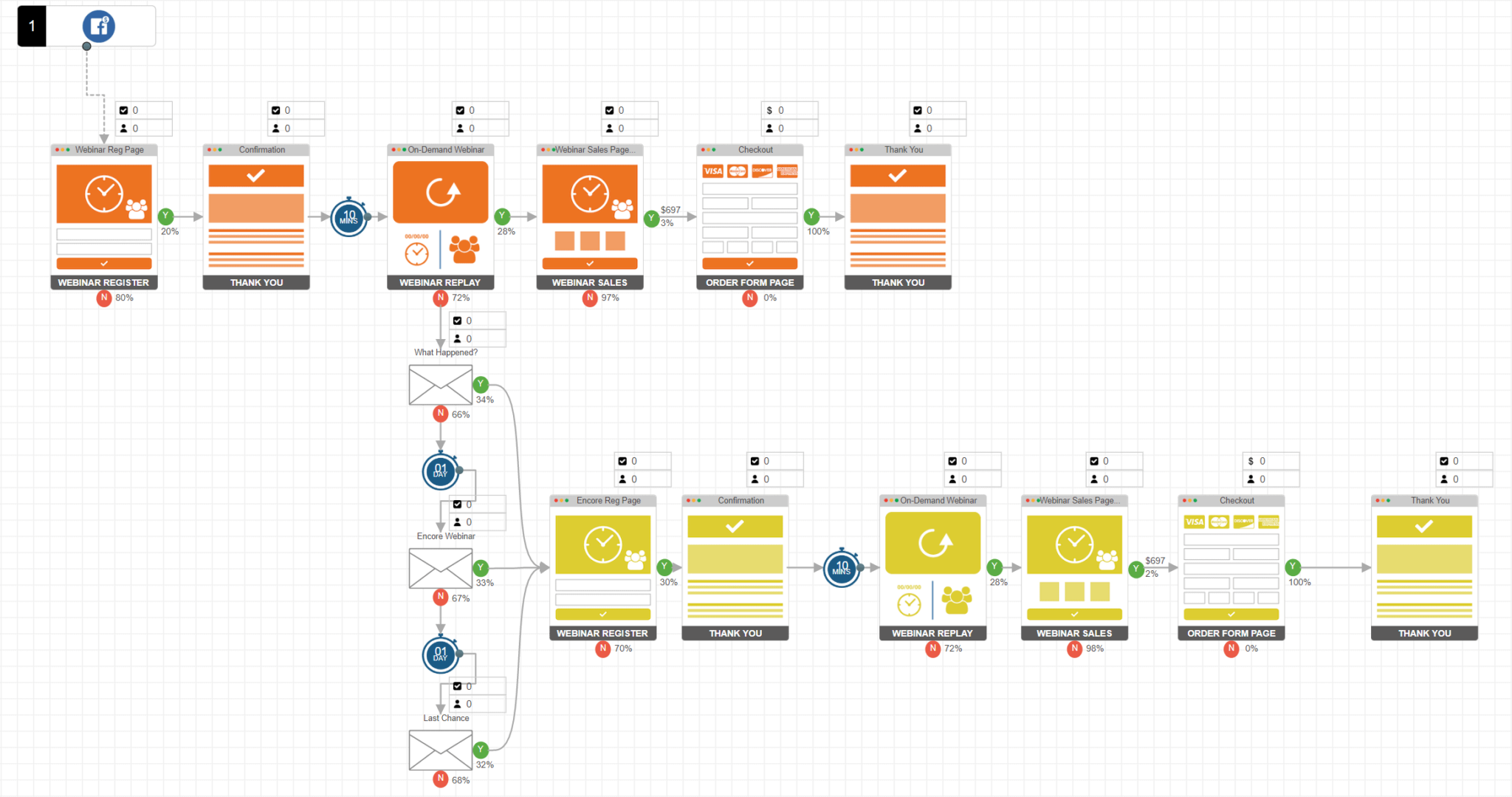
Once you have offers that are resonating, then you can loop back to productizing your expertise and start building initial versions of your course/membership/program.
There are many different types of sales funnels. At a minimum these are the ones we recommend for most online entrepreneurs:
Lead magnet funnel – Provide a small piece of valuable information in return for someone providing their email address
Webinar funnel – Deliver an automated/evergreen webinar (video) that helps your audience get to know, like, and trust you and generate interest in your product/service.
Product / Course Sales funnel – This is the direct sales funnel for your product/service. It educates the prospect on all of the benefits and outcomes of your solution and provides a way for them to purchase access and for you to collect payment.
Appointment scheduling funnel – If you provide any kind of 1:1 service or high ticket program (as we recommend) in many cases those require a phone call between you and your prior to a sale. This funnel lets potential customers choose a time you allow on your calendar to book a call.
There are 25+ more funnel types that can be added over time depending on your specific business and needs.
The main idea is to get the main four built as quickly as possible so you can start collecting data on what works and what doesn’t.
To build sales funnels you need both tools (like ClickFunnels, LeadPages, or WordPress, etc.) and content such as the videos, copy, and images that will be used on the pages in the funnel.
In addition to the sales funnels themselves, you will begin building an email list using an email service provider such as ActiveCampaign (which we recommend)
At this point you will also need to establish a basic branding and style guide. This is a step people spend WAAAY too much time obsessing about. To start, focus on a text based logo, choose a color palette, and select font pairing.
Checklist: Fire Up Your Funnels
- Determine which funnels to use for each product/service in your value ladder
- Choose an email service provider for collecting opt-ins, delivering emails, and setting up marketing automation
- Choose a funnel building tool and/or build funnels on your website (we prefer to build funnels on our client’s websites; when we can’t we use ClickFunnels)
- Design and build your sales funnels
- Setup checkout/payment processing
- Thoroughly test your funnels on desktop and mobile, all the way through purchase and delivery
Step 4 – Power Up Your Web Presence
Step 4 is all about building your web presence. Note that you are pretty far into building your expert business before we even talk about websites. Far too many people spend far too much time and money creating fancy logos, business cards, and websites before they ever even try to sell their product/service and validate their ideas.
Since that is already happening in Step 3 with your sales funnels up and running, now is the time to build a basic website which will be the foundation and headquarters of your expert business.
One of the strongest beliefs we have in our agency is that the headquarters of your business should be a website that you own and control. Do NOT build the core of your business on rented land such as Facebook, Kajabi, or any of the dozens and dozens of SaaS products/companies that want to lock you into their proprietary platforms. Many of those are great for certain aspects of your business, but your website should be built on WordPress and 100% under your control.
For our clients we recommend having two websites:
- A top-level, personal brand website. This can be as simple as a one-page website on your personal domain (i.e. johnsmith.com). If you think about your personal brand as a holding company or conglomerate, this top level site highlights each of your “divisions”. As an example, you may have a corporate career, plus the expert business you are building, plus maybe you are active in a philanthropy, and maybe you also have a serious hobby. Each of those may have associated sites, social media channels, etc.
- Next is the website for your expert business. This can also start as a simple site and then grow to contain your entire business (courses, memberships, e-commerce, etc, etc.) Just like with your funnels, the main idea is to get a basic site built very quickly, then iterate and improve over time.
Your website should at a minimum have Home, About, Products/Services, Contact pages along with a Blog. Analytics and tracking should be enabled so that you know who is visiting your site and whether they are opting in to your lead magnets. As this will become an increasingly important part of your expert business, you need to be sure your site is secure, backed up, and monitored for uptime.
When we build sites for our clients, we use an open, state-of-the-art combination of WordPress-compatible tools that enable best in breed functionality for each website element. In addition to the basics mentioned, advanced page building/editing, online course platform, podcast platform, sales funnel platform, ecommerce platform, and many more are integrated and tested so that our clients never have to worry about technology.
Should you decide to build your site yourself, below is the general process and elements we recommend building from a foundation up to an elite site.
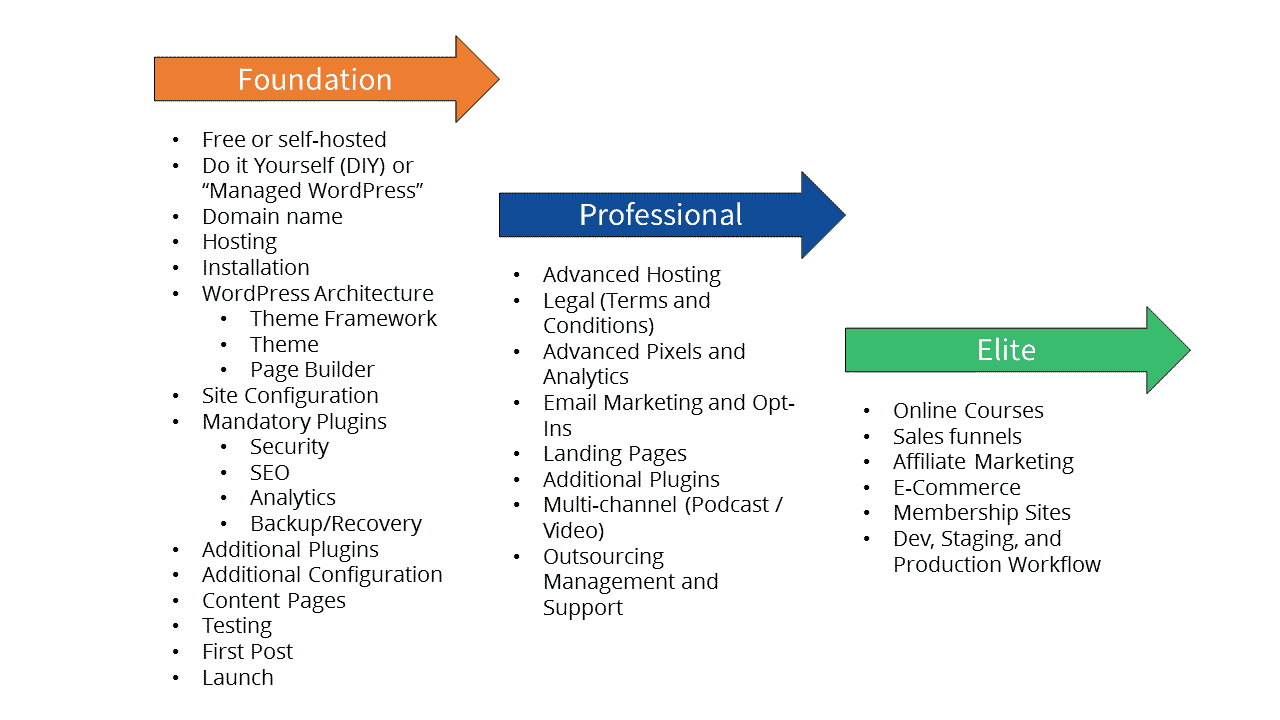
Checklist: Power Up Your Web Presence
- Decide how many websites you need (one or two)
- Buy the required domain names
- Choose your website hosting provider, we use and recommend LiquidWeb
- Decide whether you are going to build your platform and website yourself or get help
- Try not to get tempted into using “all-in-one” SaaS platforms that lock your entire business into one company
- If you are not technical, do NOT get bogged down in WordPress, themes, plugins. Get help!
- Map out the minimum foundation you need for your website (the core pages)
- Map out the minimum functionality you need (ex. Opt-ins, landing pages, etc.)
- Make sure you have a plan for monitoring uptime, security, backups
- Build and launch your site
- Remember that done is better than perfect
Step 5 – Turn On Your Social Channels
With your sales funnels up and running and your website headquarters established, it’s not time to start turning on your social channels.
Your social channels can include one or more of the following:
- Blog
- Podcast
- YouTube Channel
- Facebook Page
- Facebook Group
- Instagram Profile
- TikTok
- etc.
While it’s easy to create an empty blog, podcast and sign up for accounts on social media, what we mean by turning them on is having a defined content plan, an initial set of content for each, professionally designed profile photos, covers, post templates, etc.
How many social channels to turn on depends on your specific situation. If you are a solopreneur and trying to do it all yourself, then focusing on a single social channel until you master it makes sense but is very limiting since you will be competing with larger players who are omnipresent across all channels with content teams supporting them.
If you become a client of ours or hire your own help, then you can turn on multiple social media channels and increase your odds of success.
Checklist: Turn On Your Social Channels
- Determine the social channels most important to your business/audience
- Rank the priority of your social channels
- Setup and claim the user accounts / profile names on ALL social networks
- Create and upload professionally designed cover art and profile pictures
- Configure privacy and security settings on all social networks
- Establish processes for attracting followers to your channels
- Create branded social media post templates
- Choose an implement a social media scheduling tool
Step 6 – Start Your Content Engine
At this point, all of the required infrastructure is setup for your expert business. You should be seeing initial data from your sales funnels and potentially even early sales. It is now time to start creating valuable content to fuel your website, email marketing, and social channels and to begin building your email list and subscribers.
Your content needs to both educate and motivate your audience into taking the next step and opting into your email list, watching your webinar, booking a sales call, or purchasing your products.
The exact content strategy you need depends on the specifics of your blueprint but there are some common themes.
First, you need to put out at least one piece of valuable, long-form content every week. For our clients, we strongly urge them to focus on video content. The reason is that video content tends to be the most engaging and most promoted on social media AND video can be turned into dozens of different formats, highlights, and posts.
Your content strategy depends on your expert business blueprint: you mission, market, outcomes, and business. If you are going into a new market where you don’t have an existing audience, then your content strategy needs to revolve around helping people get to know, like, and trust you.
Initially, how-to content or educational content is a great place to start. Educational content is a great way to begin demonstrating your expertise. But as you begin to build an audience, you need to quickly learn the skill of creating conversion focused content. Meaning content that does a bit of education, but also opens loops, challenges assumptions, and leads people to your products and services.
The reason we call this step the “Content Engine” is because we strongly agree with the Gary Vaynerchuk approach for organic traffic which is to create large amounts of valuable content across all of the social media channels.
The difference is, solopreneurs don’t have a 20-person content team and 24×7 videographer like Gary V does…
But you can get part of the way there by doing extreme content re-purposing.
Remember the weekly piece of valuable content you’ll be doing? What is that 20 – 30 minute video was able to be turned into 50 different assets? Imagine that in return for two hours of planning and recording, you could get back:
- A video for your YouTube channel
- A video for your Facebook page/group
- A LinkedIn video
- A podcast episode from the audio
- A blog post from the transcript
- 3 – 5 short video highlight segments for TikTok, Reels, and YouTube Shorts
- 3 – 5 short audio highlight segments
- 3 – 5 quote images for social media posts
- 10 – 20 text posts (Tweets, status updates, etc.)
Yes if you try to do that by yourself it will take a lot of time. But if you have a team working for you, all of the above can be outsourced.
The key is getting maximum exposure and ROI for the investment you make in creating content.
Your content engine over time builds a huge library of content that attracts organic social media and search traffic.
Your content is also the foundation upon which your paid traffic (ads) strategy is built.
Checklist: Start Your Content Engine
- Choose your primary content format (video, audion, or written)
- Create a content strategy (topics / themes)
- Create a content plan (formats / audiences)
- Create a content calendar (post types / schedules)
- Plan and create content at least 4 weeks ahead of publication
- Re-purpose core content into 20 – 50 assets
- Optimize your content for search (SEO)
- Create and schedule posts
Step 7 – Green Light Your Traffic
There are two primary methods to create traffic to your content and funnels: organic (search) and paid (ads). Organic is a bit of a misnomer as it implies “free” which is incorrect. Creating content, optimizing for SEO, etc. all take time which equals money or opportunity cost.
Relying exclusively on organic traffic is a recipe for very slow growth, if any, of your online business. Yes you will hear stories of a few unicorns able to be successful “without spending a penny on ads”. While a few of those are legitimate, many are folks with huge followings from other endeavors that brought those audiences over to their new business.
In this step, green lighting your traffic means levering up your content engine with BOTH organic strategies AND paid ads. These could be Facebook, YouTube, or other ad platforms depending on your specific business.
The benefit of paid strategies is that you don’t have to hope that Google’s algorithm loves your content and sends traffic your way. Instead, you buy traffic and guarantee that your content gets seen.
The key is creating content, products, and services your market needs and desires, then making sure your paid traffic campaigns target those audiences.
When properly designed, implemented, and managed, paid traffic campaigns can generate rapid growth of your online business.
When improperly designed, implemented, and managed, you can burn cash very quickly and/or get banned from Facebook and other ad platforms.
This is another step where hiring an expert is recommended so that your odds of success are much greater from the start. Like all of the topic areas in this blueprint, ads are deep area of specialization.
Checklist: Green Light Your Traffic
Organic Strategies
- Ensure all content is optimized for search on the specific platforms where it will be posted (i.e. correct keywords for Google, correct hashtags for Instagram, etc.)
- Optimize post timing for maximum reach
- Leverage your email list and followings on one social network to promote your posts on your other channels
- Respond to all comments and engagement on your content
- Implement tracking and analytics
Paid Strategies
- Research and create audiences for your ads
- Create and implement both branding AND direct sales ad campaigns
- Create and implement “Ad Funnels” that show different ads to your target audiences based on where they are in your sales funnels
- Implement retargeting campaigns
- Implement tracking and analytics
Step 8 – Engage Your Autopilot
At this point, your online business is fully up and running! Your plan is in place, your sales funnels are live, your website is live, you are creating weekly content, your content engine is turning that into dozens of assets, and your paid traffic campaigns are ensuring your content is being seen.
You are also doing a LOT of work, even if you are already outsourcing some of these tasks!
In this step, it’s time to start automating everything you can. Any time you can automate, you should. And before you outsource anything, you should see if you can automate it first.
If you don’t have the tech background or experience in automation, then it’s definitely worth hiring an expert because paying someone to automate something is a one-time cost vs. outsourcing the work which is a recurring cost.
What are some examples of automation? What if every time you completed a video, you copied it into a folder and social media posts, transcripts, conversion into a podcast, and more were all automatically completed for you?
How about automated email follow up sequences for people who viewed your sales funnels but did not buy?
Automation is the ultimate “force multiplier”!
Checklist: Engage Your Autopilot
- Being documenting all of the repetitive activities you are doing every day and week
- Assess which steps or tasks can be automated using tools like your email service provider, social media scheduling tools, or Zapier (a popular automation platform)
- Start automating the tasks that can be automated
- Be sure to document what your are automating, how, and why
Step 9 – Team Build To Win
The final step is building your team. Many will try to bootstrap and do everything solo, even all the way here to step 9. If so, then they will likely have taken months or (I fear) years to get to this point 🙁
Regardless, it is impossible in 2022 and beyond to reach 6, 7, or 8-figures alone. Your competition has teams of people supporting them. There is no solopreneur making 7-figures in “passive income” while sitting on the beach if they don’t have a large team behind them.
As you see from this blueprint, successful online businesses require skills in:
- Tech
- Design
- Editing
- Copywriting
- Content
- Marketing
- Advertising
- Project Management
- Support
No one is an expert in all of those. Trying to learn or become an expert in all of those is extremely expensive and time consuming.
Every single task we’ve outlined in this blueprint will have people trying to sell you $2,000 courses to learn to do yourself. Even if you could affor 20 x $2,000 courses, and even if you learned how to do all these things, you’d still not have enough time to do them!
This is where outsourcing comes in. There are many different paths. Some use “virtual assistants”, a term that used to mean largely off-shore resources in the Philippines or India but today really is a generic term meaning “someone you pay to do work”. The range of prices, experience, and hand-holding required varies greatly.
While some have success with the VA route, more often than not we see people get frustrated with how much they still have to do themselves or manage even with a team of VA’s working for them. It basically turns you into a project manager.
Instead, we recommend thinking about a team of experts / specialists.
The challenge is, hiring and managing a full time team like that is also extremely expensive and time consuming. We actually don’t recommend building your own team until you are making at least $250,000/yr in your online business.
So how do we build a team without hiring a team? In the next section we’ll present the Expert Business Model which shows how to do exactly that.
Checklist: Team Build To Win
- For tasks that can’t be automated and that don’t make sense for you to do, consider outsourcing them
- Create specific job descriptions for each role that you need
- Determine the priority order of the roles you need on your team (usually Tech, then Marketing, Project Management, Design, Copy, Ads, Support)
- Be sure to use trial projects, interviews, reference checks and other due diligence before hiring any part-time or full-time resources
- Consider service providers and agencies instead of hiring/managing your own staff
The Expert Business Model (“How to build it”)
How you build your expert business is more important than what you build. An average strategy, executed well will outperform a perfect strategy poorly executed.
No matter what guru or gurus you follow online, the number one way to fail in executing their strategies (or our expert business blueprint) is to try to do it all yourself. That would be like Elon Musk trying to design, build, market, sell, and maintain Tesla cars all by himself.
The next mistake people make once they realize they need help, is they try to find a magical “virtual assistant” for $6/hr in the Philippines that is an expert in tech, design, marketing, ads, SEO, blogging, etc. not asking the obvious question of “if they really could do all that, why aren’t they building their own business or charging a lot more?”… The answer is that such a resource doesn’t exist. There are many great VAs, we use a bunch, but they are not the answer for a struggling solopreneur.
The primary challenge that your business model needs to solve is ensuring YOU are able to spend 100% of your time in your “zone of genius”, the areas where you are already an expert. That means creating content, serving your customers, attracting new customers. It is NOT learning about blogging, messing around with WordPress, trying to learn Facebook ads.
There is a business model that allows you to have that 100% focus. We call it the Expert Business Model. We discovered this during our research and work with successful online entrepreneurs. The top difference between the successful online entrepreneurs and those who aren’t is having a second in command you can delegate entire functions to (like tech, marketing, etc.)
The best description of this concept comes from the book Rocket Fuel:
“Visionaries have groundbreaking ideas. Integrators make those ideas a reality. This explosive combination is the key to getting everything you want out of your business. It worked for Disney. It worked for McDonald’s. It worked for Ford. It can work for you.” – Rocket Fuel, Gino Wickman
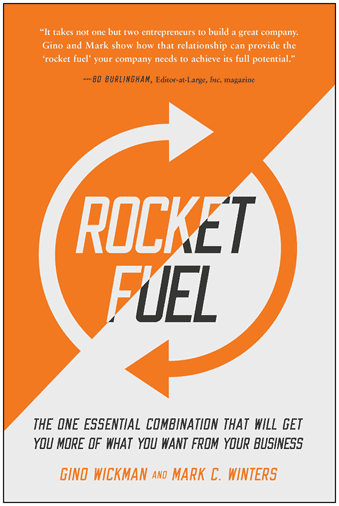
Your Virtual COO
The first key element of the Expert Business Model is what we call a “Virtual COO” (i.e. the Integrator) which is your (the Visionary’s) second in command.
The reason this is SOOOOO important is that it’s the key to freeing up your time. Having a highly qualified second in command is what enables you to delegate and stop worrying about entire aspects of your online business. It does NOT mean you aren’t involved, it simply means you and your COO set a vision/direction and the COO ensures it gets executed.
Rather than you managing flaky virtual assistants, freelancers, vendors; or you figuring out tools / systems / processes / etc., your COO is responsible for all of that.
The reason this is a virtual role, at least in the beginning, is because you need a highly qualified individual for this role, so part time / fractional makes the most sense.
You may not be aware that these types of folks exist, but they do!
Your Virtual Team
While your virtual COO will be able to do a lot, the same logic applies to them as it does to you: they should be focused on THEIR zone of genius which is managing, systemizing, and improving your online business.
You and your virtual COO need a virtual team comprised of the various skills and expertises that your online business needs like tech, design, copywriting, etc.
As with the COO, eventually you may need full time resources in some or all of these areas, but in the beginning, your virtual COO can put together and manage a virtual team, bringing in the right skills when needed, only for as long as needed.
Systems and Tools
The final element of the Expert Business Model is systems and tools. The sooner that EVERY aspect of your online business is built, documented, repeatable, and predictable, the quicker you can scale your results.
Ideally your virtual COO will have built or created similar businesses and systems in their prior experience, that is one of the key hiring criteria for that role.
Whether they do or not, that is one of the COO’s key responsibilities: systemizing your entire business.

The Expert Business Agency (“How to get it built for you”)
If you’ve made it this far, you now have the exact path for creating your own expert business! The 9 steps of the Expert Business Blueprint, and the three elements of the Expert Business Model are what the successful, 6, 7, and 8-figure online entrepreneurs use to build their businesses.
But you are also probably overwhelmed with how much needs to be learned, build, managed, and optimized in order to be successful.
The problem is that solopreneurs cannot hire full time teams to compete with those already successful. Then, as we’ve demonstrated, there is far more work to be done than a solopreneur can do themselves.
When I discovered how powerful the combination of a virtual COO, team of experts, and systems can be, I completely changed the direction of my business and started building an agency to provide these services to skilled professionals wanting to build and online business or add online programs to their existing businesses.
We created a SHARED model to help struggling solopreneurs accelerate their progress WITHOUT having to hire and manage a full-time team.
David Ziembicki, Expert Business Agency
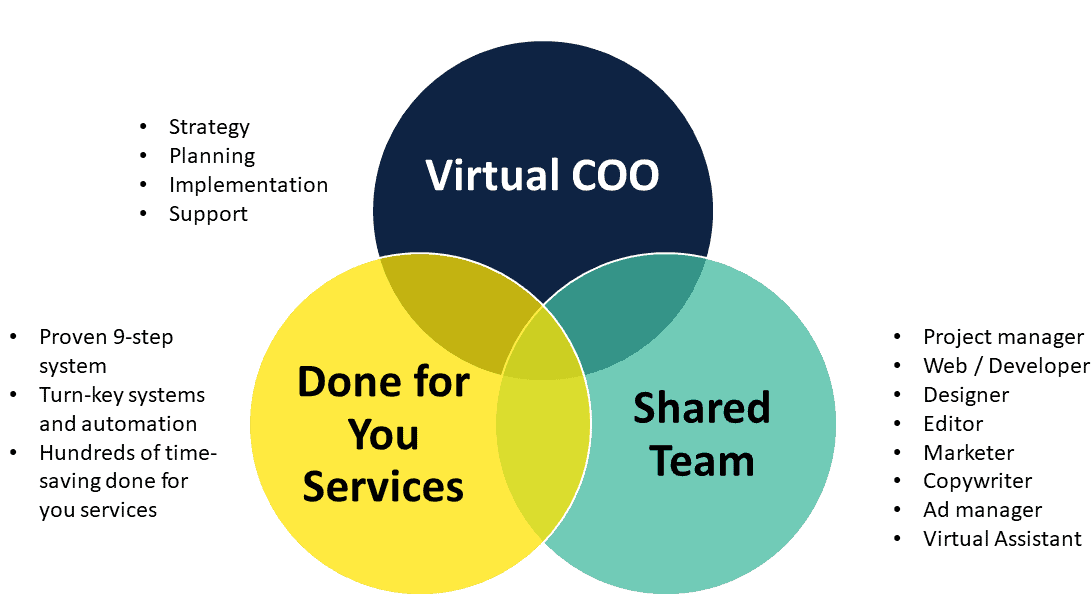
Want Help With The Expert Business System?
If I offered you a virtual COO, shared team, and done for you services to get your flagship course/program built, launched, and generating revenue – would you take me up on that offer?
Once launched, if I offered you continued access to your virtual COO, shared team, and done for you services to continue building and optimizing your online business, would you take me up on that offer?
Then apply for my free training for more details!

David Ziembicki
David Ziembicki is the founder and CEO of the Expert Business Agency, which helps coaches, course, and membership creators build their online businesses. David has been an industry-leading technology and business consultant for over 25 years having worked at Microsoft, Deloitte, SAIC, and Avanade.
